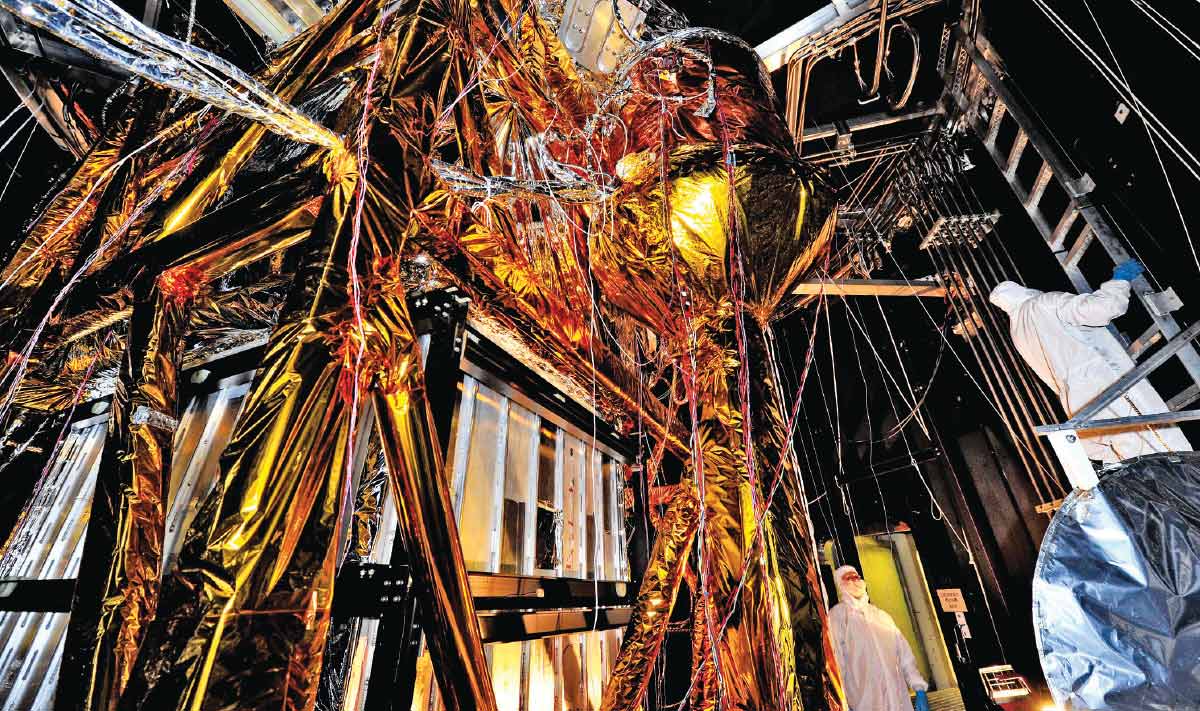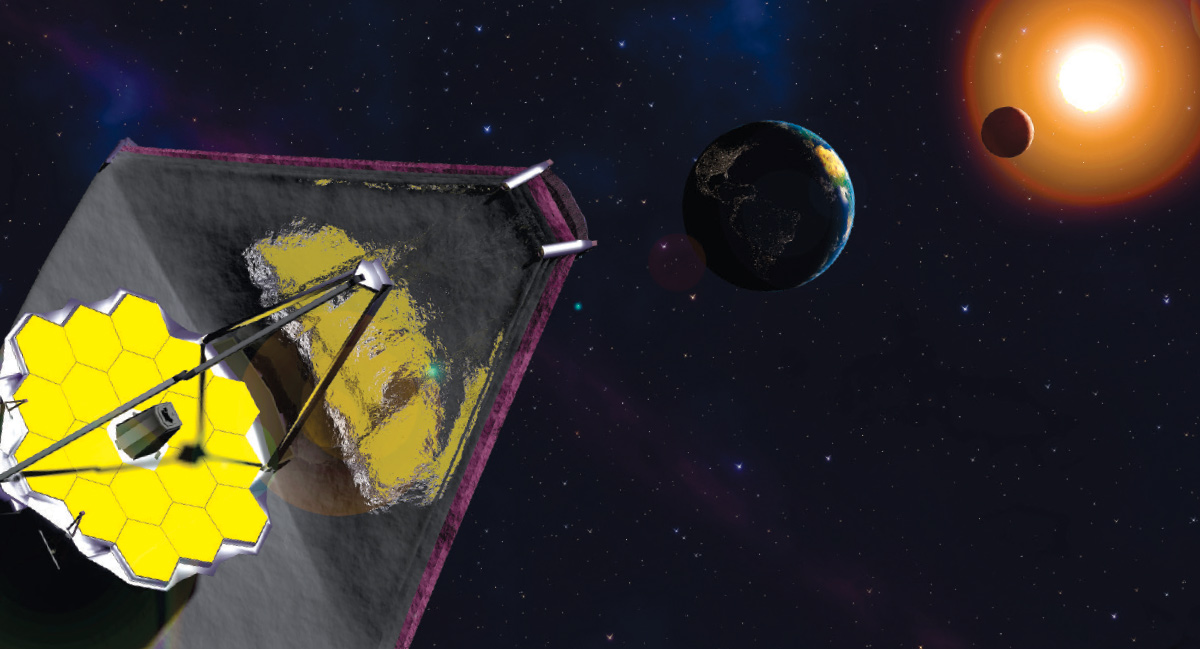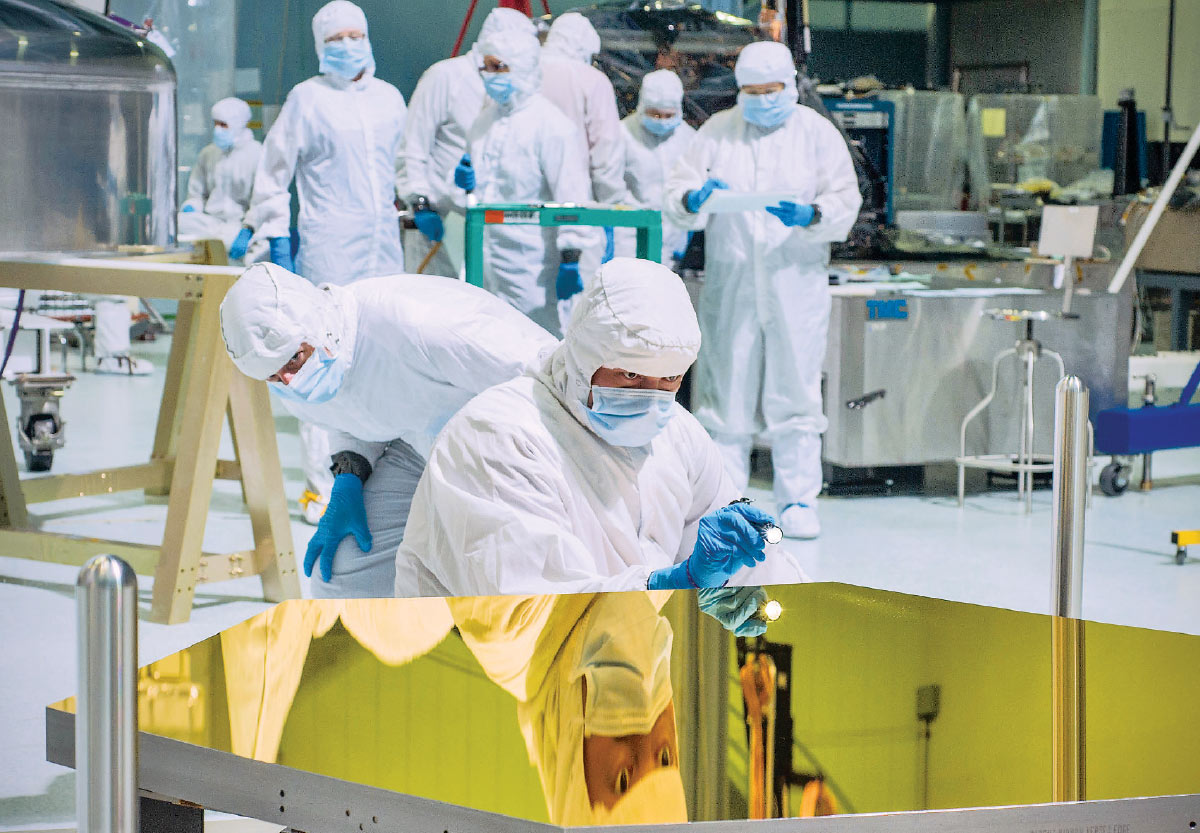Combining Forces

Some said the scheduled launch for the Webb telescope in 2007 was overly optimistic, says John Mather ’68, H’94. “People laughed at us right away and said that we couldn’t do that. But they did not tell us to stop, because it was really clear that NASA headquarters wanted to do this.”
Combining Forces

Some said the scheduled launch for the Webb telescope in 2007 was overly optimistic, says John Mather ’68, H’94. “People laughed at us right away and said that we couldn’t do that. But they did not tell us to stop, because it was really clear that NASA headquarters wanted to do this.”

Though the coronavirus pandemic has kept Mather at home, it hasn’t stopped the Webb telescope, a quarter-century in the making, from inching toward its date with destiny. Later this year — on Halloween, if the schedule holds — the successor to the Hubble Space Telescope will launch from French Guiana, unfurl its 18-faceted fly-eye mirror, and then travel to a point a million miles from Earth. From there, it will peer deeper into space and time than Hubble could: to the era when, like fireflies coming out at twilight, stars first started to light up one by one against the universe’s deepening dark.
A second goal, which has become much more topical in recent years, is to discover exoplanets (i.e., planets orbiting other stars) and look in their atmospheres for chemicals that could be indicators of life. Although the search for the first stars and images of habitable worlds may be the most likely headline-grabbers, it’s the lure of the unknown that really excites Mather. “I would consider it a success if the big discovery was something we weren’t expecting,” he says. “I would place my bet on ‘none of the above.’”
The Calm Leader
The only thing that seems refreshingly ordinary about the Webb telescope is the man at the (scientific) helm. Mather takes every opportunity to downplay his personal importance. “We have a very large team of younger people, and I don’t tell them what to do,” he says. (So far, several thousand people have worked on the Webb telescope.) “My job these days is mostly to get out of their way, because they already know what to do.”
Maggie Masetti, who leads the Webb telescope’s social media team, says, “John is the nicest, humblest person you’ll ever meet.” Once, she says, a tour guide was showing some visitors around the Goddard Space Flight Center when they happened to run into Mather in the hall. “D.J. [the tour guide] asked him to introduce himself, and John said that he was the senior project scientist for the Webb telescope. Then D.J. said no, tell them who you really are. He practically had to force it out of him that he was not just the project scientist but a Nobel Prize winner.”
Swarthmore Professor of Astronomy Eric Jensen has a John Mather story, too. “Three or four years ago, we happened to be riding up the escalator together at a meeting, and I asked him how things were going with the Webb telescope. He told me that the spacecraft was going through testing on the shake table the next week.” The shake table simulates the violent vibrations of a launch, and a lot of delicate science instruments break on their first try. “I asked him if he was nervous or worried,” continues Jensen. “I still remember his answer, because it’s been an inspiration to me. He said, ‘No, I’m not worried because I don’t take it personally. If there’s a problem, we’ll find out what it is and fix it.’ He is super calm and pragmatic.”
The future Nobel laureate grew up in rural northern New Jersey in a family that strongly encouraged his interest in science. He had a small telescope as a child, which he built himself from lenses and then a mirror he ordered from Edmund Scientific. He did extremely well in math and science competitions and attended a summer physics program at Cornell University. But, as he wrote in his Nobel Prize bio, “My parents reminded me frequently that I would still have to work hard in college.”
At Swarthmore, Mather did work hard. Freshman physics was too easy, so he asked if he could take sophomore physics instead. “They gave me the sophomore physics book, and I spent the whole Christmas vacation doing every problem in it,” he says. But he didn’t succeed in everything. He remembers struggling to pass art history and music history, and he avoided courses that prioritized writing. (He has, in fact, written a book about the COBE mission, 2008’s The Very First Light.)
As a student, Mather idolized the physicist Richard Feynman, but in graduate school at the University of California, Berkeley, he figured out that not everybody could be a Feynman. The most crucial experiment for his dissertation — an attempt to measure the spectrum of the recently discovered cosmic microwave background from a balloon — ended in failure. That disappointment planted the seeds of an amazingly successful career. He learned two important things. First, the experiment had to be done in space. Second, the team had been in too much of a hurry and had cut corners. The lesson would serve him well on COBE, which took 16 years to get off the ground, and the Webb telescope, which has taken 26. A large part of that time has been spent making sure everything works right. In space, you don’t get second chances.

Cold, Gold, and Big — the Story of a Telescope
Almost 14 billion years ago, the universe began expanding in an event called the Big Bang that can be described but not explained. After 378,000 years, the universe had cooled enough for hydrogen atoms to form. Space became transparent, because there were hardly any stray ions left for light to bounce off of. COBE brought us a snapshot of that moment. We discovered that the universe was colorless but not featureless; it had slight density fluctuations, which have condensed into the stars and galaxies of today.
The next snapshot we have, thanks to Hubble, is a billion years later. At that point we see a universe already filled with adolescent stars and galaxies. We are missing the formative years, and that is what Mather and other astronomers are hoping to see with Webb. To capture the universe in its childhood, we need a telescope that is sensitive to infrared light. The older a star is, the more its light has been stretched out by the universe’s expansion; this makes the light redder, a phenomenon called “redshift.” For stars 14 billion years old, it is a huge effect: Light that was initially ultraviolet would be shifted clear over to the infrared spectrum, completely bypassing the range of visible light.
This infrared telescope needs to be cold, gold, and big. Cold, because anything warm produces its own infrared light, which swamps the faint light coming from the heavens. Gold, because gold is a near-perfect reflector of infrared. (It’s a poor reflector of blue light, which is why it looks yellow-red to us.) Big, because these first stars are more than 13 billion light years away from us, and therefore very faint. Webb’s 18 primary mirrors have more than six times the total light-collecting area of Hubble’s single mirror.
Always — another Swarthmore Connection
Twenty-five years later, Marcy’s prediction will finally come true, and two of the people who will make it so are from Swarthmore. Beth Biller ’00 and Andy Skemer ’06 are co-principal investigators of “High-Contrast Imaging of Exoplanets and Exoplanetary Systems.” It is one of 13 projects designated for the Early Release Science phase of the Webb mission, a sort of shakedown period when the telescope will both do high-quality science and test out the four instruments on board, making sure they work and giving astronomers a chance to practice using them.
Although a few exoplanets have been photographed from ground-based observatories, the photos from Webb will have higher resolution, and they will have full infrared spectra. That is, they will be in color (though not the kind we can see). The photos might, for example, show if these Jupiter-like planets have clouds or perhaps even rings. Biller and Skemer will be in a very similar position to 17th-century astronomers like Galileo and Huygens, looking at Jupiter and Saturn through the very first telescopes. There is no telling what they will find, and everything is possible.
—Dana Mackenzie ’79

Webb has been very expensive, because it pushes the limits of feasibility in so many ways. (The current price tag is about $10 billion.) In 2011, Congress began to balk at the continued delays and increasing cost, and at one point the House Appropriations Committee zeroed out the telescope’s budget. “Congress was interested in whether there was a plan or whether this was spiraling out of control,” says deputy mission scientist Jonathan Gardner. “I think that [eliminating the budget] was part of the process to make sure that NASA would come up with a plan.”
As a NASA employee, Mather was not allowed to lobby Congress, but he did write a letter to The New York Times, signed by 31 other Nobel Prize winners. “Everyone I contacted wanted to help,” Mather says. The Nobel laureates, the contractors, and the public prevailed. Congress restored and, in fact, increased the funding, and the launch date was pushed to 2018.
The last of Webb’s many delays was due to the coronavirus pandemic, which suspended assembly and testing for a few weeks last year. Gardner says Webb actually got lucky, because all the hardware was in one place, at Northrop Grumman. “If it had been five or 10 years ago, the pieces would have been all over the country and all over the world,” he says.

There’s a story about that, too. Mather always saw this mission as an international venture, and the European Space Agency signed on for 15% of the cost. (Canada has also provided 5%.) NASA and ESA agreed that the latter would provide the launch vehicle, an Ariane rocket. That is why the mission will launch from the ESA spaceport in French Guiana, and it’s why this 21st-century technology has to take such an early 20th-century route to outer space.
It’s not surprising that Mather would want to make it the world’s telescope. If one value has dominated his career, it’s collaboration. Nothing this big gets done without the contributions of many people. “How do we know all these things about the universe and the Big Bang?” he asks. “Not because we’re individually brilliant, but because we have been thinking about them for a hundred years, and because we combine forces.”